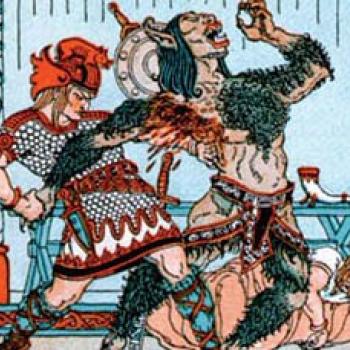An Introduction to Beowulf: Language and Poetics

- Preview |
- Standards |
- Resources & Preparation |
- Instructional Plan |
- Related Resources |
- Comments
Overview
This lesson provides an introduction to the language and poetics of the epic poem Beowulf. Although this lesson assumes students will read Beowulf in translation, it introduces students to the poem's original Old English and explains the relationship between Old, Middle, and Modern English. Students are introduced to the five characters in the Old English alphabet that are no longer used in Modern English. As a class, they translate a short, simple phrase from Old English, and then listen to a passage from the poem being read in Old English. Next, students are introduced to some poetic devices important to Beowulf. They learn about alliteration by reading an excerpt from W. H. Auden's modern English poem “The Age of Anxiety,” then listen for alliteration in the Old English version of a passage from Beowulf. Finally, students explore the poetic functions of kennings, compounds, and formulas in Beowulf.
Featured Resources
Beowulf: Language and Poetics Quick Reference Sheet: This reproducible provides information about the difference between Old, Middle, and Modern English, as well as poetic devices found in Beowulf.
Literary Guide: Beowulf: This online tool can serve as an introduction to Beowulf, presenting information about the poem's significance as well as an overview of the story.
From Theory to Practice
Gillis argues that when we teach literature we often don't do so without teaching its background, its historical, philosophical, and environmental context. When teaching literature in translation, he argues, if we fail to consider the original language and stylistic features of that piece, then we have not taught all the background necessary for our students to have a full understanding of that literary work, even if we are not experts in that language. The purpose behind introducing students to the original language and style will foreground for them that they are reading a translation, which at its best can only give us "an inkling" of the original work.
Further Reading
Common Core Standards
This resource has been aligned to the Common Core State Standards for states in which they have been adopted. If a state does not appear in the drop-down, CCSS alignments are forthcoming.
State Standards
This lesson has been aligned to standards in the following states. If a state does not appear in the drop-down, standard alignments are not currently available for that state.
NCTE/IRA National Standards for the English Language Arts
- 1. Students read a wide range of print and nonprint texts to build an understanding of texts, of themselves, and of the cultures of the United States and the world; to acquire new information; to respond to the needs and demands of society and the workplace; and for personal fulfillment. Among these texts are fiction and nonfiction, classic and contemporary works.
- 2. Students read a wide range of literature from many periods in many genres to build an understanding of the many dimensions (e.g., philosophical, ethical, aesthetic) of human experience.
- 3. Students apply a wide range of strategies to comprehend, interpret, evaluate, and appreciate texts. They draw on their prior experience, their interactions with other readers and writers, their knowledge of word meaning and of other texts, their word identification strategies, and their understanding of textual features (e.g., sound-letter correspondence, sentence structure, context, graphics).
- 6. Students apply knowledge of language structure, language conventions (e.g., spelling and punctuation), media techniques, figurative language, and genre to create, critique, and discuss print and nonprint texts.
- 9. Students develop an understanding of and respect for diversity in language use, patterns, and dialects across cultures, ethnic groups, geographic regions, and social roles.
- 11. Students participate as knowledgeable, reflective, creative, and critical members of a variety of literacy communities.
- 12. Students use spoken, written, and visual language to accomplish their own purposes (e.g., for learning, enjoyment, persuasion, and the exchange of information).
Printouts
Websites
Preparation
- Review the lesson and decide which elements you wish to use.
- Review the Beowulf: Language and Poetics Quick Reference Sheet.
- Print out for each student a copy of each handout you wish to use.
- For more background information on Beowulf see Beowulf: A Study Guide
- Test the Literary Guide: Beowulf on your computers to familiarize yourself with the tool.
Student Objectives
Students will
- be introduced to Old English, the language of Beowulf.
- know the relationship between Old English and Modern English.
- learn about alliteration and alliterative verse.
- understand kennings, a poetic device common to Old English poetry, and how they are used in Beowulf.
Session One: Introducing Old English
- If desired, use the Literary Guide: Beowulf to introduce the poem. The Overview outlines basic information about the poem.
- Using the Quick Reference Sheet as a guide, explain that English is divided into three periods.
- Introduce students to the unfamiliar letters used in the Old English alphabet. Use the Language section of the Literary Guide: Beowulf to discuss the five characters in the Old English alphabet that are no longer used in Modern English.
- You may want to write the letters on the board and/or show them the first page of Beowulf. In case they ask, the manuscript dates to about 1000 CE and was damaged in a fire, which is why the top and right hand side of the page are badly damaged. The entire Old English alphabet is available in section 16.2 of The Electronic Introduction to Old English.
- If you would like to spend a few minutes illustrating the changes between Old English and Modern English, write “Þæt wæs god cyning.” on the board, explain to the class how to pronounce the various sounds, and see if they can translate the sentence into Modern English. If you want to provide an example of how Chaucer might write that sentence, you can add “That wes good king,” “That wes goode king,” and/or “That wes god king” to the board after the class has translated the Old English sentence.
- If you would like the class to hear some of Beowulf in the original Old English, pass out the Old English Beowulf Passage Handout and have the class go to https://www.beowulfresources.com/. While the students can listen to and see four Beowulf passages at this site, the handout covers lines 1–11 of the prologue.
Note: while now is a logical time to listen to Beowulf read in Old English, your students may get more out of listening to the poem if you introduce alliteration and alliterative verse to them first (see below). You may also wish to distribute the Modern English Beowulf Passage Handout which provides a translation of the passage.
Session Two: The Poetics of Beowulf
- Using the Quick Reference Sheet as a guide, explain alliteration. You may wish to begin illustrating alliteration by using tongue-twisters as examples. The excerpt from W. H. Auden’s poem “The Age of Anxiety” and the Old English Beowulf Passage Handout can be used for further examples.
- Once your students understand the concept of alliteration, pass out the excerpt from W. H. Auden’s poem “The Age of Anxiety” if you have not done so already.
- Show the example of alliteration in the Poetics section of the Literary Guide: Beowulf.
- Using the Quick Reference Sheet as a guide and the Auden poem, explain the basics of Old English alliterative verse. (Do not work through the whole Auden poem if you wish the students to work on the assignment alone or in groups.)
- Once your class seems to have an understanding of alliterative verse, you may wish to turn to the Old English Beowulf Passage Handout, listen to the poem (see number 4 in the first session), and identify the alliteration and meter of the first 16 lines of Beowulf.
- Pass out the Modern English Beowulf Passage Handout if you have not done so already and/or show the example of kenning and compounding in the Poetics section of the Literary Guide: Beowulf. Using the Quick Reference Sheet as a guide, explain to your students the concepts of compounding and kenning. While your particular translation may or may not include the compounds and kennings of the poem, the Modern English Beowulf Passage Handout provides examples for you and your class to examine and discuss. The compounds represented by the translation are “Spear-Danes,” “mead-benches,” “hall-troops,” and “boy-child.” The one kenning in the passage is “whale-road.” While some of these compounds also function as formulas (see Quick Reference Sheet), they also have specific poetic functions. Ask your students to discuss the poetic function of compounding and kennings in the passage.
Example: The Old English for Spear-Danes is Gar-Dena. If you look at the Old English Beowulf Passage Handout, you will see that gar (spear) alliterates and that the alliterative meter needs a G-word here. And, if you are familiar with the poem, you will know that Danes are compounded with many words: Ring-Danes, East-Danes, North-Danes, South-Danes, West-Danes, Bright-Danes. As this is the case, it would be simple enough to suggest that the meter requires the use of gar in this compound for metrical purposes, and, sometimes, this is the reason for the use of a particular word or compounding. However, it is worth noting that this passage is about the Dane’s conquests against their neighbors. It would seem then that the use of gar (spear) in this formulaic compound was not only to meet the needs of the alliterative meter, but also to foreground the Danes as an aggressive tribe. Here in the first line of the poem we find meter, poetic flourish, and theme all coming together in the poem’s first use of compounding.
- Either as homework or in class, ask your students to identify the stresses and alliteration in the Auden poem. You may also ask them to do the same with the Old English Beowulf Passage Handout. If you ask them to work with the Old English passage, give them the URL for audio files and suggest they listen to each section before marking the passage.
- If your translation maintains compounding and kennings, select some good passages and ask your students to identify the compounds and kennings and explain their function.
Extensions
- Formulas: Review the formula section of the Beowulf: Language and Poetics Quick Reference Sheet and The Electronic Introduction to Old English section on formulas (14.3) and have students look for formulas as they read Beowulf.
- Variation: Review the variation section of the Beowulf: Language and Poetics Quick Reference Sheet and The Electronic Introduction to Old English section on variation (14.2) and have students look for variation as they read Beowulf.
- Follow this lesson with the ReadWriteThink lesson, Reading Literature in Translation: Beowulf as a Case Study.
Student Assessment / Reflections
Session One
- Observe your students as you work through and discuss Old English and its relationship to Modern English. Do they seem interested and engaged with the discussion? Do their comments and questions demonstrate a growing understanding of the material?
- If you plan on giving quizzes or exams which cover Beowulf, consider including questions on some of this material. If you plan on doing so, let your students know this as you introduce the material to them.
Session Two
- Observe your students as you work through and discuss the poetics of Beowulf and Old English alliterative verse. Do they seem interested and engaged with the discussion? Do their comments and questions demonstrate a growing understanding of the material?
- Either informally discuss Auden poem after your students have completed them, or, alternatively, collect and grade them.
- If you asked your students to identify and explain compounding or kennings in the poem, have them share their findings with the class, or, alternatively, collect and grade their work.

Add new comment